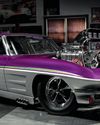
As domestic manufacturers fought for engineering supremacy following World War II, it was Chrysler that emerged with unique research produced from an experimental inverted V16 engine with over 2,500 hp and 36 liters of displacement called the IV-2220. When mounted to the airframe of a Republic P-47D Thunderbolt, the hemispherical IV-2220 was able to sustain level flight at 504 mph at 15,000 feet. Despite this being unheard of for a prop-driven aircraft, the military contract was canceled. New-fangled jet-powered aircraft were the future, but the breakthrough engine still had a role to play, albeit in greatly modified form.
By 1949, both Cadillac and Oldsmobile had introduced new overhead-valve V8 engines, which were perceived as a premium relative to the flatheads and straight-eights of the era. Overhead V8 designs were more compact and lighter in weight, and they generated more power per cubic inch than flathead engines due to their breathing efficiency. By introducing the first production Hemi V8 in 1951 as the Chrysler FirePower V8, then in 1952 in the DeSoto as the FireDome V8, Chrysler Corporation was able to leapfrog over GM by adding another crucial technological advantage to the overhead-valve formula: the hemispherical combustion chamber. Let's look at the many Hemi engine sizes Chrysler built over the years.
The First-Generation
この記事は Hot Rod の May 2022 版に掲載されています。
7 日間の Magzter GOLD 無料トライアルを開始して、何千もの厳選されたプレミアム ストーリー、9,000 以上の雑誌や新聞にアクセスしてください。
すでに購読者です ? サインイン
この記事は Hot Rod の May 2022 版に掲載されています。
7 日間の Magzter GOLD 無料トライアルを開始して、何千もの厳選されたプレミアム ストーリー、9,000 以上の雑誌や新聞にアクセスしてください。
すでに購読者です? サインイン

What Is Pro Street?
You know it when you see it.

Pro Street in Pure Vision
Builder Steve Strope weighs in on the Pro Street look and what he would build today.

THE GAS ERA LIVES ON
These vintage race cars chart the evolution of technology in the early days of drag racing.

MOTOR HEAD FOR LIFE
Scott Sullivan is one of the original Pro Street pioneers. He still builds cars today out of a small shop in Dayton, Ohio.

BRINGING BACK PRO STREET!
David Freiburger and Roadkill Garage built a Pro Street Nova.

SWEET ASPIRATIONS
Jerry and Matthew Sweet added an 800ci Pro Stock mountain motor to chase HOT ROD Drag Week's Pro Street NA Record.

Making Bad Decisions Badder
Bradley Gray's 1970 Nova is a Hybrid! It's a streetable Funny Car.

ART PROJECT
This Rad Rides by Troy-built '63 split-window Corvette went from restaurant prop to ripping up the street!

WHERE DO WE GO FROM HERE?
THE PRO STREET ERA PEAKED IN THE '80S. ARE WE IN THE BEGINNING OF A RESURGENCE?

Making Connections
Project T-top Coupe: We install a Terminator X Max for big power.